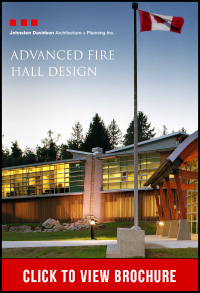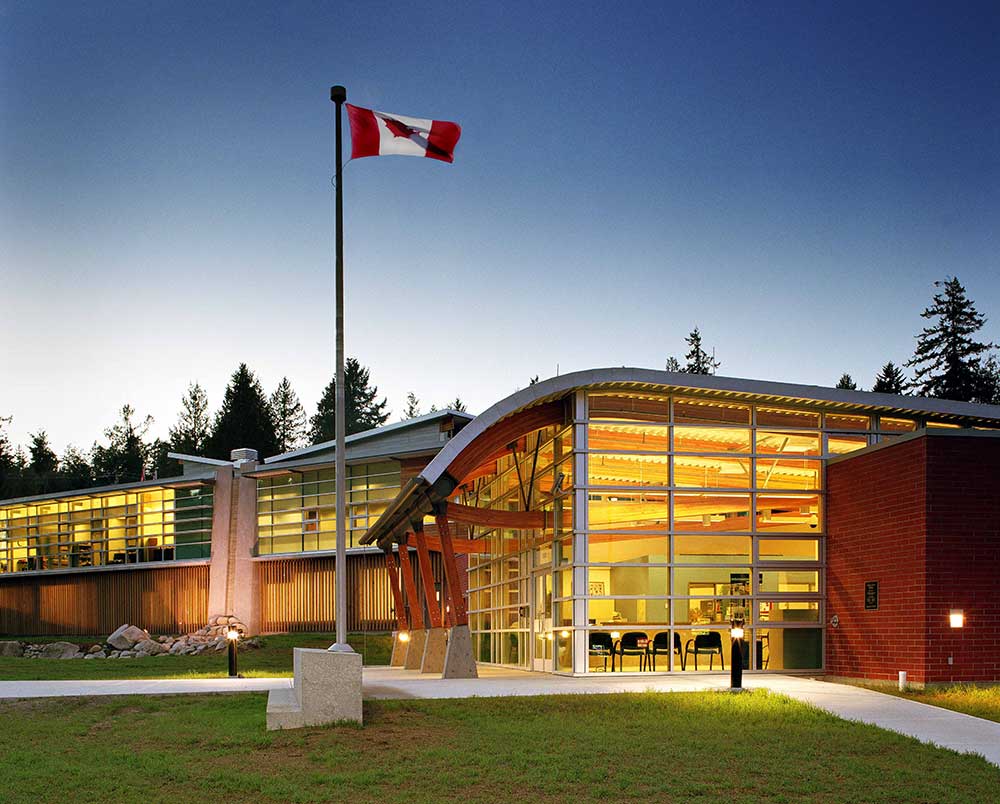Advanced fire hall design
 With one foot planted firmly in tradition, Johnston Davidson’s future is bright.
With one foot planted firmly in tradition, Johnston Davidson’s future is bright.
Think fire-engine-red bright.
Led by Principal Kimberly Johnston and Associates John Botelho and Ed Craig, the Vancouver-based architecture firm celebrates 40 years of outstanding architecture and design this year.
For over four decades, the firm, founded by Douglas Johnston and Ian Davidson—both life time members of the AIBC—has built an impressive resume in municipal, residential, public institutional and health care buildings.
While the firm still has a very busy general practise, Johnston and Davidson is carving out a speciality for its work designing fire halls.
Community Showpieces
Kim Johnston, principle architect and daughter of the late Douglas Johnston, says—factiously—that over 40 years ago, fire halls were thought of as glorified garages. But in the last decades, there has been a significant evolution in the roles of fire halls.
As a public space, the design must keep community access a priority, not only for emergency services, but also public access. “The building becomes part of a neighbourhood and integration the community is key when designing fire halls,” says Johnston. “Many now incorporate meeting rooms for the community. Exercise areas and bigger kitchens are common, and technology to improve the health and safety of first responders is advancing every day—all while coordinating municipal responses to emergencies.”
Johnston and Davidson enjoy creating a building that will be a community show pieces, and consider the history of the site as they design. Their fire hall in the township of Fort Langley, for example, is a beautiful interpretation of the historical Hudson’s Bay Fort and reinterpretation of architecture of early Canadian settlements. “It creates a really nice relationship between the men and women who work in fire protection and the community they serve,” Johnston says.
Technical Complexity
Johnston calls it a marriage of architectural form and siting: Johnston and Davidson create community showpieces that can also deal with highly technical elements. Take the Qualicum Beach Fire Hall, for instance. The fire hall is a six-bay (three tandem drive-thru bays) fire hall designed with administrative offices, a large training room, and a fitness room. On the more technical side, decontamination washrooms were included, along with gear storage and drying room, gear washer/utility room, SCBA room, workshop, and a training/hose tower.
With over 50 fire halls on their roster, from communities of a few thousand to Vancouver—with the highest population density in the country—Johnston and Davidson are experts on the subject.
“The idea that this building type can translate across so many different community needs is really exciting to see.”
Sustainability
The use of wood is an over-arching theme for all of Johnston and Davidson work, and is a major contributing factor to the sustainability of the firm’s designs. “People tend to think of wood as being a residential product, but that is only one aspect on how it can be used,” says Johnston. “It brings a lot of joy to people when exposed wood becomes part of the architectural language.”
Locally-sourced wood is an important element in an environmentally-sustainable design, which focuses on energy reduction, and as these buildings are publicly-funded projects, using local materials ensures some of the budget is cycled back into the community.
Cross Laminated Timber, for example, is lauded as an alternative for conventional materials such as steel or concrete, and used in 90 per cent of the firm’s protective services projects. Mass timber panels used for floors and roofs have helped in the generation of such measureable results as the 72 per cent energy reduction of Johnston Davidson’s Qualicum Beach Firehall design. “One of the prime sustainable goals for our projects is to achieve the highest energy reduction possible for a building regardless of its function and size,” says Johnston.
Looking Towards the Future
Community has always played a big part in the design intent Johnston and Davidson’s portfolio. This translates both in their work and as well as amongst their peers. Johnston adds she thinks her father would marvel at the way architects can collaborate through technology. “One of the great advantages of the digital age is that you can work with people across the country much more easily than you used to be able to,” says Johnston. “Whether that is through trading drawing files or design ideas, it makes that work much easier and certainly benefits reaching clients in remote areas.”
Johnston says her father and his partner “would have really enjoyed the idea of this digital community and the fact that you can communicate so easily with people. Design professionals love to have the ability to communicate their design intent so when you find groups you can collaborate with and work with as a team, its very rewarding. We have done our best to strike a balance between acknowledging what is a design trend, but always pushing the boundaries and understanding how we can modify lessons of the past to meet with goals of our future.”
To celebrate the 40th anniversary, the agency is sharing 40 moments from its design history on its Instagram account, @jdarch1976.






